What Type of Castors Should We Fit
Schools and public halls have a duty of care to its children, staff and visitors to make sure all safety equipment is in place and equipment used is safe to use. Safety castors and brackets must be fitted to all upright pianos that are not fixed to the wall. Pianos are very heavy; fitting the wrong type of castors can cause the piano to be unstable and dangerous.
Ensure you fit the correct type and use the appropriate screws, if you are in any doubt then seek the advice of your local piano tuner, who should be able to fit or advise you. Grand pianos should have an "A" frame fitted. The "A" frame supports the legs of the piano when it is moved. If a grand piano is on a stage then locking wheels should also be fitted. 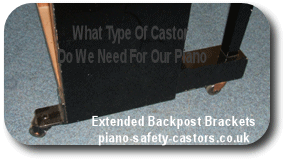
Extended Backpost Brackets
Light weight adjustable safety brackets are not suitable for large pianos like the Yamaha U3. for those we recommend extended back post brackets and twin wheel castors. product SN-723 or SN-723-b By increasing the wheel base, these rear toes greatly reduce the danger of tipping an upright piano over backwards; particularly important when unskilled labour is used to move pianos in school halls and classrooms. The extended leg at the front of the piano should have matching castors to keep the piano in balance and for eases of movement. The extended toe set we sell comes with four matching castors two fitted to the metal extenders and two for the frount legs. 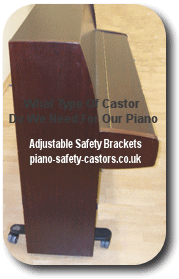
Adjustable Safety Brackets
Adjustable safety brackets with castors are designed to suit any depth of small modern upright piano product High-load twin-wheel castors ensure safety and ease of movement. They come in light weight FN-725A. or heavy weight FN-725 . The light weight one are for pianos up to 116cm high and movement on sold floors. The heavy weights are for piano over 116cm high and are suitable for movements on carpets or hard floors.
Factory Fitted Safty Castors
If you have a piano with Factory Fitted Safty Castors, as in the photo . Most of the time its just the rubber wheels that need changing. ( Product SN-W722B and SN-W722AB) If the castor its self has been damaged then castors SN-721P, SN-722B and SN-722AB will replace the existing ones. Just measure the plate and height of the castor. Then select the appropriate one.
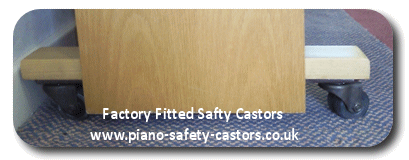
Wrong Type of Safty Castors Fitted
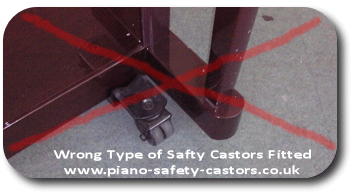 This is an example of the wrong type of safty castors fitted to a piano. They have used the cradel type when they should have used extended post. The piano rocks when playing working the screws loose eventuly they will work out an cause the castors to fail resulting in the piano faling over
This is an example of the wrong type of safty castors fitted to a piano. They have used the cradel type when they should have used extended post. The piano rocks when playing working the screws loose eventuly they will work out an cause the castors to fail resulting in the piano faling over
Damaged Wheel Tyre
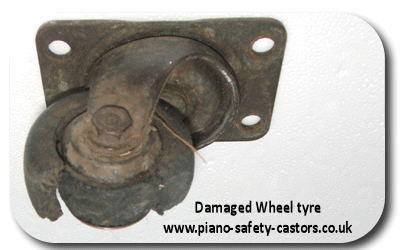
Quite often in schools and some homes its just the rubber tyre on the wheels that has gone. This is a simple fix as most of these castors have a screw in axel. Just remove the old wheel and replace with ether SN-W722B or SN-W722AB
Small Pianos With No Castors
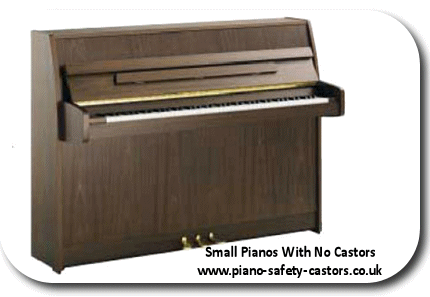 Upright Piano fitted with gliders instead of castors. This type of piano construction became popular from the 1970 onwards for their slim line case however, they are not good if you have to move the piano, especially on modern wooden floors as the gliders scratch the floor. These pianos will not support normal castors as they are too slim. Fitting normal castors will make the piano very unstable; also quite often the cast iron frame is in the way at the edges. Light weight adjustable safety brackets is the only way to fit castors on this type of piano.
Upright Piano fitted with gliders instead of castors. This type of piano construction became popular from the 1970 onwards for their slim line case however, they are not good if you have to move the piano, especially on modern wooden floors as the gliders scratch the floor. These pianos will not support normal castors as they are too slim. Fitting normal castors will make the piano very unstable; also quite often the cast iron frame is in the way at the edges. Light weight adjustable safety brackets is the only way to fit castors on this type of piano.
Grand "A" Frame
Grand piano's should have an "A" frame fitted. Also, if the grand is on a stage or platform locking wheels should also be fitted. Moving a grand piano can be dangerous, particularly if the floor surface is uneven. i.e. over floorboards or concrete. If the leading leg should “snag” the momentum of the instrument could cause the leg to buckle under the instrument with potentially serious consequences. By fitting a trolley frame this risk can be removed. They are fully adjustable and available with two types of cup fitting. Standard fitting offers more support to the legs and also come with locking wheels
- A. STANDARD (REQUIRES REMOVAL OF EXISTING CASTORS)
- B. EASY-FIT (NO NEED TO REMOVE CASTORS)
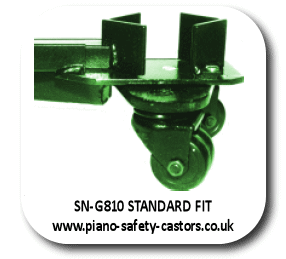 |
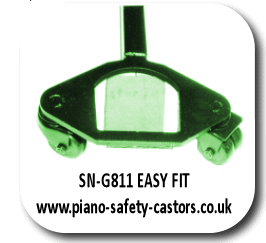 |



